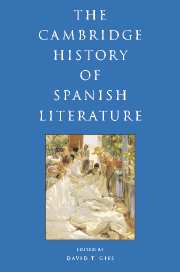Book contents
- Frontmatter
- I INTRODUCTION
- II HISTORY AND CANONICITY
- III THE MEDIEVAL PERIOD
- IV EARLY MODERN SPAIN: RENAISSANCE AND BAROQUE
- V THE ENLIGHTENMENT AND NEOCLASSICISM
- VI THE FORGING OF A NATION: THE NINETEENTH CENTURY
- VII THE MODERN, MODERNISMO, AND THE TURN OF THE CENTURY
- VIII TWENTIETH-CENTURY SPAIN AND THE CIVIL WAR
- IX IN AND OUT OF FRANCO SPAIN
- 46 The literature of Franco Spain, 1939–1975
- 47 Twentieth-century literature in exile
- 48 Prose in Franco Spain
- 49 Poetry in Franco Spain
- 50 Theatre in Franco Spain
- 51 Film and censorship under Franco, 1937–1975
- X POST-FRANCO SPANISH LITERATURE AND FILM
- Bibliography
- Index
- References
47 - Twentieth-century literature in exile
from IX - IN AND OUT OF FRANCO SPAIN
Published online by Cambridge University Press: 28 March 2008
- Frontmatter
- I INTRODUCTION
- II HISTORY AND CANONICITY
- III THE MEDIEVAL PERIOD
- IV EARLY MODERN SPAIN: RENAISSANCE AND BAROQUE
- V THE ENLIGHTENMENT AND NEOCLASSICISM
- VI THE FORGING OF A NATION: THE NINETEENTH CENTURY
- VII THE MODERN, MODERNISMO, AND THE TURN OF THE CENTURY
- VIII TWENTIETH-CENTURY SPAIN AND THE CIVIL WAR
- IX IN AND OUT OF FRANCO SPAIN
- 46 The literature of Franco Spain, 1939–1975
- 47 Twentieth-century literature in exile
- 48 Prose in Franco Spain
- 49 Poetry in Franco Spain
- 50 Theatre in Franco Spain
- 51 Film and censorship under Franco, 1937–1975
- X POST-FRANCO SPANISH LITERATURE AND FILM
- Bibliography
- Index
- References
Summary
Is there such a thing as a literature in exile? Writers such as Camilo José Cela (1916–2002) or Francisco Umbral (1935–), both of whom remained in Spain during the Franco years, have contested the value of the 1939 Spanish émigrés’ legacy. Francisco Ayala (1906–), one of the most representative intellectuals to emigrate to the Americas (Argentina, Puerto Rico, United States), upon his return to Spain voiced his doubts about exile literature and separated his intraexile or supraexile contributions in an allegorical mode – La cabeza del cordero (“The Lamb’s Head,” 1949), Los usurpadores (“The Usurpers,” 1949), and Historia de Macacos (“Macacos’ Tales,” 1955) – from any exilic connections. In post-Franco Spain, to disregard exile followed the stream of consensual oblivion regarding the memory of the Spanish Civil War and its aftermath. Ayala, a sociologist by training, understood that in order to be considered within the hegemonic cultural canon in democratic Spain, exile labels had to be rejected.
Still, his position did not reflect the view of most of the individuals who joined the extensive diaspora following the War in 1939. Most intellectuals did not have the chance to return and live through the post-Franco era, nor to view how their history slowly became politically “correct” in the late nineties, particularly when the cultural apparatus of the state signaled that exile was no longer a source of controversy, due to the cushion furnished by chronological distance and the vanishing of the protagonists. More recently, novelist Antonio Muñoz Molina (1956–) and critic Miguel García Posada (1944–) suggested that neither a formal nor a generational justification identified exile as a segregated area of production or study.
- Type
- Chapter
- Information
- The Cambridge History of Spanish Literature , pp. 620 - 627Publisher: Cambridge University PressPrint publication year: 2005



